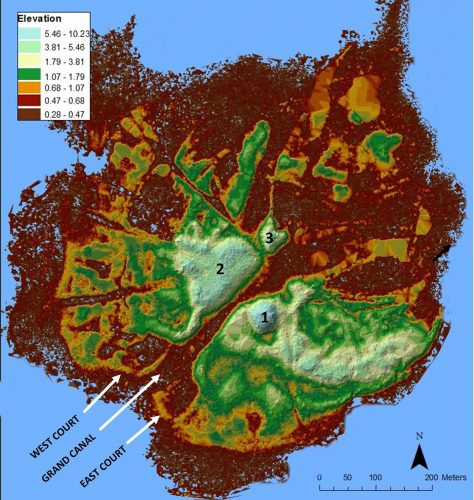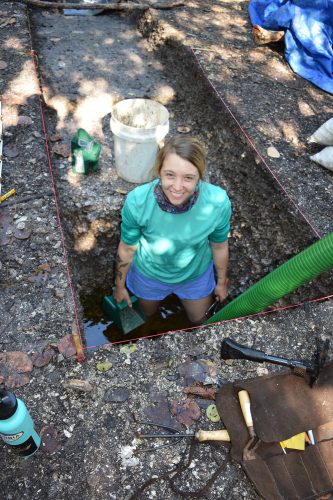On March 30 an article was published in the Proceedings of the National Academy of Sciences entitled “Ancient Engineering of Fish Capture and Storage in Southwest Florida.”

indicate Mounds 1-3; arrows point to the
Grand Canal and two watercourts. Map by
Victor Thompson.
The research on which the article was based took place on Mound Key, an island in Estero Bay near Fort Myers Beach that was the capital of the Calusa Indian nation when Spaniards first arrived. The team of researchers included Karen Walker (co-director of the RRC), Bill Marquardt (former director of the RRC), and scientists and students from the University of Florida, University of Georgia, Florida Gulf Coast University, Flagler College, and the College of Idaho. Here is a summary of the article’s main points.
Visitors to the Mound Key Archaeological State Park know that the walking path crosses the Grand Canal, located next to the highest mound, known as Mound 1. Although the Grand Canal has been partially filled in since the time of the Calusa, it is still obvious.
At the mouth of the Grand Canal are located two roughly rectangular structures. Built on a foundation of oyster shells, these “watercourts” likely were tidal enclosures, or fish traps, which also served as holding pens for fish before they were cooked, smoked, or dried. Water and fish would enter the courts at high tide, the gates would be closed off, and the fish trapped as the tide went down. Fish could then be easily captured by spearing them or catching them in dip nets or seine nets.
Designing the courts required a thorough knowledge of daily and seasonal tidal variation, as well as fish behavior, which varies by species. The courts had to be able to let in some water at high tide and allow water, but not fish, out at falling tides. Gates had to be designed to close and open for various purposes, such as herding fish in to sub-compartments, to clear out unwanted fish, or to let in schooling fish.
Storing aggressive carnivorous fish with fish species that they prey upon needed to be avoided. Some fish —mullet, for example — feed mostly on very small vegetal material such as algae and diatoms that they get from muddy sediments. Such fish would have been able to survive for longer periods of time in an enclosed court than certain other fish species. Mullet, and some other fish, can jump out of the water, so the berms had to be high enough to prevent escape. The designers must have been present to direct the actual construction.

We don’t know precisely how the courts worked, but we think that storage would have been short-term – hours to a few days, not for months at a time, before the fish were consumed, or processed for future use by drying or smoking. We think the courts would have been refreshed at high tide and held some water seeping up through the bottoms of the courts, through the oyster-shell layer that had accumulated before the courts were built.
The larger of the two structures is about 36,000 square feet – more than seven times the size of a basketball court – with a surrounding berm of shell and sediment about 3 feet high. The smaller watercourt is about 28,750 square feet. Radiocarbon dates indicate that they were constructed between AD 1300 and 1400. They were almost surely still in use when Spaniards visited the island in 1566.
Many other societies in the Americas depended on fish for protein. Fishing dates back thousands of years on the coast of Peru, for example. In Florida, net fishing dates back 6,000 years on Useppa Island according to our work there. Fishing supported complex, populous societies in California, the North American Northwest Coast, and Florida. Coastal peoples from these areas did not grow staple agricultural crops, and neither did the Calusa. What makes the Calusa different is that they achieved the status of a kingdom that ruled all of South Florida, collected tribute, supported specialists, and traded with other societies hundreds of miles away. They engineered canals, amassed earthworks, and erected enormous buildings. Their warriors resisted conquest by the Spaniards. Most other societies that achieve this level of complexity and power are principally farming cultures that are able to distribute surplus foods to ensure their influence. By investigating the watercourts, we now have more insights as to how engineering and ecological knowledge might have allowed the Calusa to capture, process, and distribute surplus fish, thereby extending their influence.
The detailed article can be found at www.pnas.org/cgi/doi/10.1073/pnas.1921708117 and will be available free of charge 6 months following its on-line publication.